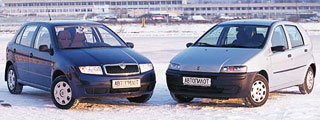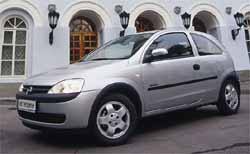Skoda Fabia 2000 test drive - 2007 -
Three cylinders with character
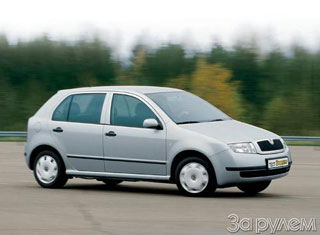 Frankly, heading for the Skoda-Fabia test with a new 1.2 liter engine, I did not experience much optimism. What to expect from such a baby, when, under the pressure of the strict environmental requirements of the Euro and IV, cars with more liters were soldered, becoming spareless in a sense.
Frankly, heading for the Skoda-Fabia test with a new 1.2 liter engine, I did not experience much optimism. What to expect from such a baby, when, under the pressure of the strict environmental requirements of the Euro and IV, cars with more liters were soldered, becoming spareless in a sense. It turned out to be so difficult to fulfill these norms that the modernization of existing gasoline engines in most cases has become economically disadvantageous. It is for this reason that in Mlada-Boleva the release of four-cylinder engines of Skoda with a volume of 1 to 1.4 liters, which properly served almost 40 years, was stopped. They were replaced by a 1.2 NTR motor (from the English expression High Torque PerFor-Mance-a high-mopping engine), which managed to run into a Volkswagen-Polo. Its two versions differ mainly by the number of valves per cylinder and, accordingly, have different power: two -valve - 40 kW, four -valve - 47 kW. Both of them will completely replace both a liter engine with a capacity of 37 kW and 1.4 liters (44 and 50 kW). The design of the motor deserves a detailed acquaintance - especially since the Polo equipped with it is not delivered to Russia.
There are two main reasons why small litting engines are increasingly doing three- rather than four-cylinder. With a decrease in the number of parts, the engine becomes easier and more compact, and in addition, mechanical losses are reduced compared to four of the same volume. It is curious that somewhat earlier a liter three -cylinder engine for class A models and in released Opel.
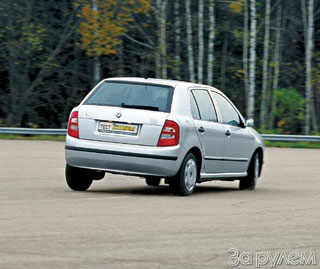 So, the 1.2 HTP engine is in a row, three -cylinder, with a four -axle crankshaft. The camshaft - light, but hard - is a pipe with fists precisely on it. Chain drive with a water supply. It is curious that the oil pump is given by a separate chain with a mechanical tensioner. Unlike belts, the service life of the chains is compared with the life of the motor.
So, the 1.2 HTP engine is in a row, three -cylinder, with a four -axle crankshaft. The camshaft - light, but hard - is a pipe with fists precisely on it. Chain drive with a water supply. It is curious that the oil pump is given by a separate chain with a mechanical tensioner. Unlike belts, the service life of the chains is compared with the life of the motor. Fists are controlled by valves through roller roller roller crooks with hydraulic compensators, significantly reducing wear and friction losses, without requiring clearance adjustment. The flow of coolant is directed not as usual - along, but perpendicular to the axis of the cylinders. Thus, the most uniform temperature regime of each cylinder is achieved, which is important for the stability of the combustion process. The ignition system is electronic contactless with a high -voltage coil directly on each candle. Nutrition is a sequential multi -point distributed fuel injection MPI. The work of both systems is controlled by the new Simens Simos 3PD unit. The throttle drive is electronic, without mechanical connection with the accelerator pedal.
The release system is combined in a new way: the catalyst is located directly behind the receiving pipe with two lambda-zonds-for control before and after. Here it warms up to the operating temperature faster, reducing the toxicity of the exhaust and fuel consumption at the same time. Carter ventilation has been significantly changed: it is controlled by the PCV vacuum control valve (Positive Crankcase Ventilation). As a result, the recirculation of crankcase gases has been improved and condensate formation was reduced.
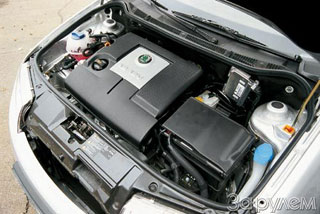 Thanks to modern technologies and materials, the engine turned out to be quite light: with a clutch and a catalyst (but without a generator and oil) - 78.3 kg. For comparison: a four -cylinder predecessor (1.4 l, 50 kW) in the same configuration, only without a catalyst, weighs 88.6 kg.
Thanks to modern technologies and materials, the engine turned out to be quite light: with a clutch and a catalyst (but without a generator and oil) - 78.3 kg. For comparison: a four -cylinder predecessor (1.4 l, 50 kW) in the same configuration, only without a catalyst, weighs 88.6 kg. We were represented by Skoda Fabia, who recently set off from the conveyor and generally familiar in previous tests-only a muffled peppy rodge of a 47-kilowatt engine of 1.2 ntr from under the hood of another. Miraculously, from the very beginning between the car and the driver, complete understanding was established. Even in the torn mode of the movement of the still unfinished city stream, a feeling of lightness did not leave. The process of control of Fabia was given the naturalness not so much soft and accurate steering, a fairly intelligible brake system, as an unusually sensitive, almost leading reaction to the movement of gas pedal. On the suburban highway, Skoda also demonstrated sufficient abuse, allowing you to bypass much more powerful cars. Smooth acceleration is achieved in all five gears. At the same time, the sound accompaniment of the motor easily gaining momentum is so unobtrusively that attempts to compete in dynamics with Toyota, Passats, Nissans are stopped only smoothly at 6500 rpm of revolutions. The temperament of the car was not so significantly reduced even the appearance of four adult riders in the cabin. Good measurements of dynamics confirmed favorable impressions.
We summarize. The new Fabia power unit not only satisfies the norms of the Euro IV, but also provides the machine with quite comfortable dynamic qualities, fully justifying the meaning of the abbreviation of the NTR - a high -muscle engine. In countries with tax and insurance benefits for small vehicles, he is guaranteed demand. What is the interest of Russian consumers - they will show time and pricing policy.
Source: The magazine "Driving"
Video crash tests Skoda Fabia 2000 - 2007
Skoda Fabia 2000 test drives - 2007
Skoda Fabia 2000 - 2007 crash test
Krassh Test: Detailed Information26%
Driver and passengers
12%
Pedestrians







